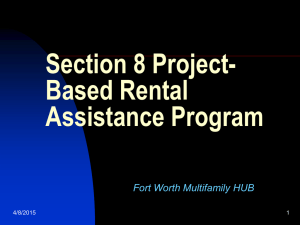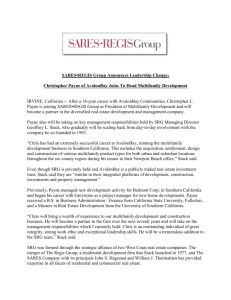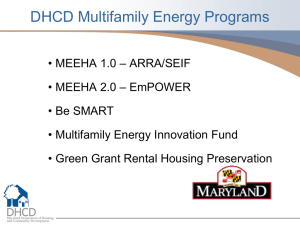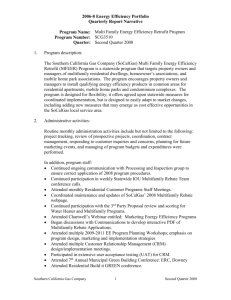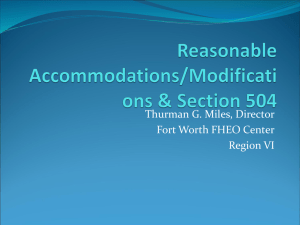This status update memo summarizes Phase 1 research activities
advertisement
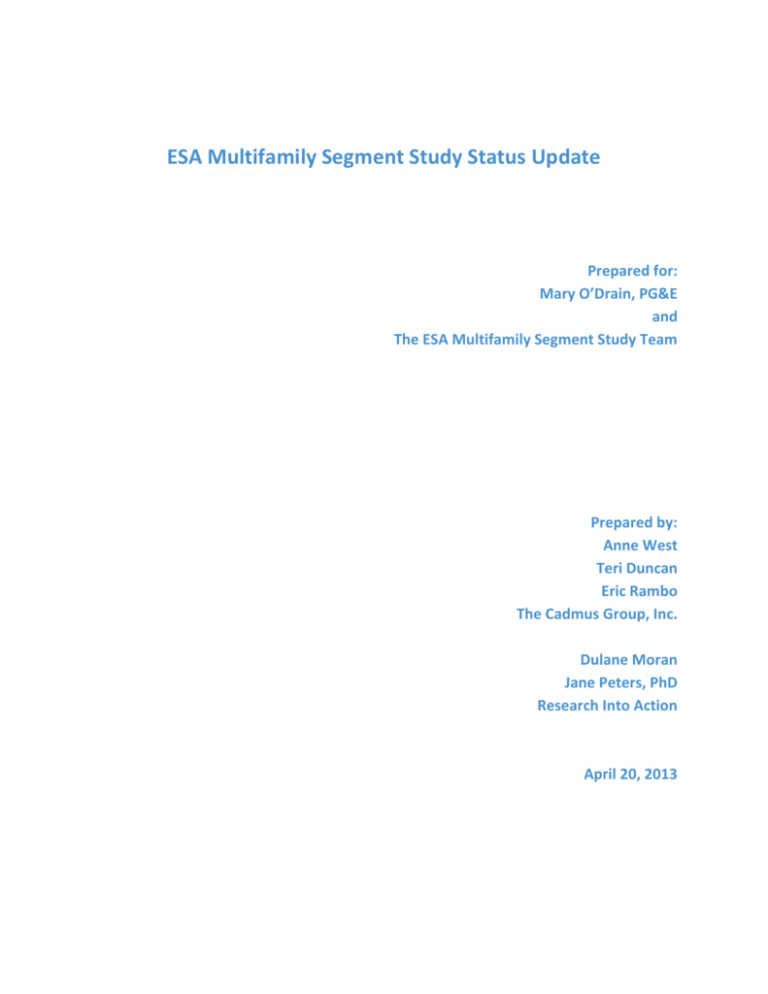
ESA Multifamily Segment Study Status Update Prepared for: Mary O’Drain, PG&E and The ESA Multifamily Segment Study Team Prepared by: Anne West Teri Duncan Eric Rambo The Cadmus Group, Inc. Dulane Moran Jane Peters, PhD Research Into Action April 20, 2013 This page left blank. TABLE OF CONTENTS Introduction .................................................................................................................................................. 1 Task 1: Project Initiation Meeting and Research Plan .............................................................................. 3 Research Plan ........................................................................................................................................ 3 Task 1 Next Steps .................................................................................................................................. 3 Task 2: Gather California Multifamily Housing Data Relevant for Low-Income Customer Programs ...... 4 Analyzing Census Data .......................................................................................................................... 4 Organizing IOU Program and Customer Data ....................................................................................... 5 Building Owner and Operator Survey ................................................................................................... 6 Sampling Plan ........................................................................................................................................ 9 Examine Comments to ESAP Proceedings .......................................................................................... 13 IOU Staff Interviews ............................................................................................................................ 15 Task 2 Next Steps ................................................................................................................................ 15 Task 3: Catalog Existing Multifamily Energy-Efficiency Programs .......................................................... 16 Task 3 Next Steps ................................................................................................................................ 17 Task 4: Review and Evaluate Multifamily Programs and Research Relevant for Low-Income Customers ................................................................................................................................................................ 17 Task 4 Next Steps ................................................................................................................................ 18 Task 5: Identify and Assess Alternative Program Designs and Delivery Strategies ................................ 18 Current Program Components ............................................................................................................ 18 Task 5 Next Steps ................................................................................................................................ 18 Task 6: Identify Financing and Funding Options ..................................................................................... 19 Develop List of Relevant Financing Options........................................................................................ 19 Review Results from Other Study Tasks and Other Studies ............................................................... 19 Task 6 Next Steps ................................................................................................................................ 20 Task 9: Conduct Public Workshop to Discuss Research and Recommendations ................................... 20 Task 9 Next Steps ................................................................................................................................ 20 Appendix A: Supporting Material for Census Tract Analysis and GIS Mapping ...................................... 21 This page left blank. INTRODUCTION This status update memo summarizes Phase 1 research activities through March 2013, conducted for the ESA Multifamily Low-Income Segment Study. The following sections discuss research conducted by Cadmus and Research Into Action (together, the Cadmus team), and specify progress made to-date. We also list the next steps to complete Phase 1 deliverables. The Phase 1 deliverables were described in the ESA Program Multifamily Segment Study Research Plan filed February 25, 2013. Separate electronic files of supporting materials are included as attachments to this report. The primary activities in this Study are designed to meet the CPUC ALJ Decision’s (D.12-08-044) research objectives. These activities and areas of focus are: Gather California Multifamily Housing Data Relevant for Low income Customer Programs Catalog Existing Multifamily Energy Efficiency Programs Relevant for Low Income Customers Review and Evaluate Multifamily Programs and Research Relevant for Low Income Customers Identify and Assess Alternative Program Designs and Delivery Strategies Identify Financing and Funding Options Conduct Public Workshops Phase 1 Highlights The Cadmus team is progressing toward meeting the Phase 1 deliverables, completing the following tasks. The team: Submitted the draft Research Plan Conducted the first public workshop and received comments from stakeholders Interviewed the ESA and MF program managers at all four IOUs Cataloged and created a summary table of public comments to the ESAP proceedings Submitted data requests to the four IOUs and received most of the data Analyzed American Community Survey (ACS) summary data, PUMS and PUMA datasets Using ArcGIS, mapped low-income, multifamily households by census tract Estimated the number of low-income multifamily households by county and IOU service territory Conducted a preliminary literature review to identify which programs to include in the catalog of nationwide programs serving the multifamily sector and particularly low-income residents Began discussions about cost-effectiveness criteria used in the ESA Program Compiling datasets to develop the sample frame for the building owner and manager surveys Completed a preliminary draft of the building owner and manager survey Summary of Next Steps Chapters for each of the key activities listed above will be delivered as they are completed, anticipating delivery of chapters for the Phase 1 report by May 1. Cadmus will then compile the individual chapters into a Phase 1 draft report and circulate to the Study Team for comments. The draft final report for Phase 1 activities will be delivered by June 14, 2013. ESA Multifamily Segment Study Status Update / April 20, 2013 1 Table 1 summarizes the next steps needed to complete the tasks that correspond to each of the research activities for Phase 1. Following the table, further detail about the progress made for each Phase 1activity to-date is provided. Table 1. Summary of Next Steps to Complete Research Tasks for Phase 1 Task Task 1: Project Initiation Meeting and Research Plan Next Steps Task 2: Gather California Multifamily Housing Data Task 3: Catalog Existing Multifamily EnergyEfficiency Programs Task 4: Review and Evaluate Multifamily Programs and Research Relevant for LowIncome Customers Task 5: Identify and Assess Alternative Program Designs and Delivery Strategies Continue reviewing documents related to ESA and multifamily proceedings. Prepare summary memo describing the approach that will be implemented in Phase 2. Organize collected data to incorporate it with data collected by Research into Action through Task 3. Review and highlight key information from the program staff interviews conducted at all four IOUs. Continue to compile data regarding California’s programs by reviewing recommendations from ESA proceedings, findings from additional studies, and research results from other study tasks, specifically Task 2 and Task 3. Compile preliminary program design strategies, options, and suggestions for discussion with the study team. Continue discussions about cost-effectiveness with the IOUs Work with the task 2 staff leads to develop questions about financial decision for the building owner/operator surveys. Task 6: Identify Financing and Funding Options Task 9: Conduct Public Workshop to Discuss Research and Recommendations Based on input from public workshop and comments posted to the Energydataweb.com site, Cadmus will submit revised draft research plan to the Study Team. Summarize current participation by census tract based on analysis of IOU participant data. Continue to track incoming customer and participant data. Compare program participation levels to the low-income multifamily household estimates by census tracts to identify underserved areas with high levels of estimated potential participants. Continue to catalog programs. Prepare progress status update for the catalog of multifamily energy-efficiency programs. Prepare Bibliography. Prepare catalog draft for submittal to Study Team April 15. Conduct a second public workshop to review the findings from Phase 1 of the study, to be held after the Phase 1 draft report is completed and submitted to the Study Team in June 2013. ESA Multifamily Segment Study Status Update / April 20, 2013 2 Task 1: Project Initiation Meeting and Research Plan The Cadmus team joined the study team—Mary O’Drain, Pacific Gas and Electric (PG&E); Carol Edwards, Southern California Edison (SCE); Brenda Gettig, San Diego Gas & Electric (SDG&E) and Southern California Gas (SoCalGas); and Tory Francisco, California Public Utilities Commission (CPUC)—for the project initiation meeting in San Francisco on January 18, 2013. Representatives from the California independently owned utilities (IOUs) and the CPUC Energy Division also attended the meeting. During the meeting, Cadmus presented an overview of the scope, research approach, and activities for the study. The presentation included key project milestones and their associated timelines. Meeting participants also identified and discussed critical issues for consideration during the study. Following the meeting, Cadmus prepared and delivered a memo of the meeting’s minutes, documenting the key points to be considered for the research plan, action items and next steps, and items open for further discussion. RESEARCH PLAN The Cadmus team developed and submitted an outline for the research plan on February 6, 2013, for approval by the study team. The first draft was submitted on February 8. In response to comments from the study team, we submitted a revised draft plan on February 21. Based on direction from the study team, Cadmus created a new and more accessible version of the plan for the public workshop. In this version, we streamlined some of the tables, explained the phases of the activities, and moved the more lengthy details to an appendix. The revised draft for the public workshop was submitted on February 25. The Energy Division posted this draft to energydataweb.com for review by public stakeholders in advance of the workshop. Comments on Research Plan from Public Stakeholders During the first public workshop, held in San Francisco on March 5, 2013, Cadmus received feedback on the draft research plan from the stakeholders in attendance. Additional public comments were posted to energydataweb.com. TASK 1 NEXT STEPS Based on input from public workshop and comments posted to energydataweb.com, Cadmus will submit a revised draft research plan to the study team. We prepared an appendix with comments from each provider and will address comments in additional appendices. ESA Multifamily Segment Study Status Update / April 20, 2013 3 Task 2: Gather California Multifamily Housing Data Relevant for Low-Income Customer Programs ANALYZING CENSUS DATA In January and February, Cadmus gathered and reviewed publicly available data to identify characteristics of low-income households in multifamily dwellings. In the process, we found that one source—American Community Survey (ACS) summary data, which is available as pre-defined tables at the census tract level—could not be used directly to determine the intersection between low-income inhabitants who also live in multifamily buildings. Tabulating this intersection is possible only by estimating census tract households using proportions from the more aggregate Public Use Microdata Sample (PUMS). Unlike the census tract data, PUMS data can be directly manipulated as individual household records; however, these data are identifiable only for a larger geographic area, the Public Use Microdata Area (PUMA). This restriction is imposed to ensure the confidentiality of respondents. Whereas a census tract may comprise as few as 2,000 residents, a PUMA comprises approximately 100,000 residents. For each PUMA, we calculated the percentage of households meeting the low-income criterion of 200% of federal poverty guideline and residing in buildings with five or more units. Our approach was as follows: The PUMS datasets for each state include housing- and person-level records. For example, a five-person household has one record in the housing dataset and five records in the person dataset; a serial number ties the five-person records to the one-household record. Cadmus defined a household as meeting the low-income criteria if one person in that household earned less than 200% of the income defined by the federal poverty guideline. We counted the number of households meeting both multifamily and low-income criteria for each PUMA. This value was divided by the total number of multifamily households within that PUMA to obtain the percentage of multifamily households below 200% of the federal poverty guideline. This percentage represents the conditional probability that a household meets both the low-income and the multifamily criteria. We excluded records for group or institutional quarters. The ACS five-year data summaries provide counts of housing units by number of units in the building. There are also summaries of the number of people at different income-to-poverty index levels; but, because these data are available only in pre-populated summaries, it is not possible to map these counts of people to counts of households. Therefore, Cadmus determined that the best method for estimating the number of low-income, multifamily households was to use the conditional probability computed at the PUMA level of the intersection of low-income and multifamily household status. We applied this proportion to the count of multifamily households within each census tract to obtain an estimate of the number of low-income and multifamily households within that tract. ESA Multifamily Segment Study Status Update / April 20, 2013 4 For 2011 U.S. Census data, census tracts are not nested within PUMAs. Cadmus determined1 the percentage of each census tract overlapped by a PUMA and used this proportion to adjust population counts2. These proportions, along with the PUMA-level conditional probabilities, were multiplied by the census tract level counts of multifamily households. These results in turn were summed by census tract, in order to obtain the number of low-income, multifamily households within each census tract. Appendix A provides a map of the results described above, as well as summaries of the census tract estimates by county and IOU service territory. ORGANIZING IOU PROGRAM AND CUSTOMER DATA Data Tracking Cadmus set up a secured FTP site for IOU program administrators to transfer data that we will use to analyze past and current trends in program participation. These data are stored in an encrypted file network and accessible only to the data-analysis team. Each transferred file is catalogued in a spreadsheet to track data requests and receipts. Status of Data Received Cadmus produced a memo for the four IOUs that provided detailed information about the data needed for the study. In February, we began receiving participant data for the Multifamily Energy Efficiency Rebate Program (MFEER) and the Energy Savings Assistance Program (ESA) and began reviewing the data. All four IOUs have provided MFEER and ESA participant data to Cadmus. Cadmus has screened the MFEER and ESA participant datasets for completeness and all appears to be complete at this time. All participant data received to date has been cleaned and integrated into a SQL database for further analysis. Cadmus has received data requested in item 2 of the data request memo, which is account data flagged as a multi-family account, from SCE. PG&E is in the process of transferring this data and Cadmus is making further inquiries with SCG and SDG&E. This information will be used to identify the population of low income multifamily buildings in each IOU service territory. Table 2 lists the data provided by each IOU. Table 2. Status of Participant and Account Data Received Data Received? (Y/N) Data requested GIS data layer of each utility territory for GIS mapping (e.g., shape files). SCE PG&E SDG&E SoCalGas Y Y Y Y Notes Received from Energy 1 Using ArcGIS’ ‘Union’ tool 2 Assumes uniform distribution of population. Dasymetric mapping was outside the scope of this analysis. ESA Multifamily Segment Study Status Update / April 20, 2013 5 Data Received? (Y/N) Data requested Customer account data multi-family accounts (dwellings of 5 or more units) with any flags indicating a common area account and CARE tariff. ESA (LIEE) participant dataset covering last 3 years. ESA (LIEE) participant dataset from 2009 process evaluation. MFEER participant dataset covering last 18 months. Datasets for other programs serving multifamily customers and low income multifamily buildings. SCE PG&E SDG&E SoCalGas Y In Progress In Progress In Progress Y Y Y Y In Progress Y In Progress In Progress Y Y In Progress Y In Progress In Progress Notes Commission Cadmus is following up with PG&E, SDG&E, and So Cal Gas Cadmus will compare results of the current study to the 2009 study. Y In Progress Cadmus is following up with utilities. Expect to obtain results of the DRA dataset for each utility. BUILDING OWNER AND OPERATOR SURVEY In January and February, Cadmus gathered and reviewed multiple public data sources of low-income property owners and managers. These sources, for which we determined there is some overlap, are: Multiple Assistance and Department of Housing and Urban Development (HUD) Section 8 Contracts Database U.S. Department of Agriculture (USDA)affordable rental property list California Tax Credit Allocation Committee List HUD’s Low Income Housing Tax Credit list The data provided by the IOUs will include information to identify common areas and, potentially, contact information for building owners and managers. These data will be included in the sample frame. Cadmus is drafting the survey to gather information about the property, property owner, and tenant characteristics. Cadmus is incorporating questions from the MFEER process evaluation survey and developing additional questions as needed to cover areas of interest. List Sources Cadmus researched several ways to identify a comprehensive list and a sample frame from which to complete 300 surveys with property owners and managers. We have researched both public and ESA Multifamily Segment Study Status Update / April 20, 2013 6 purchased lists. The public lists will help us assess the market characteristics among properties with low income tax credits, rental subsidies, and other affordable housing funding or subsidies. The lists that we could purchase will augment the study by providing a comprehensive picture of the multifamily housing market. ACS data indicate there are a small percentage of condominiums owned by low income families. Since the numbers are small, they will be difficult to identify. We will contact stakeholder groups to request information about these and other small groups. We will not develop a separate survey strata for low income owners of condominiums. However, we will pay particular attention to identifying low income owners of condominiums. We may interview a small number outside of the parameters of the random sample (if they are not picked up through random sampling). Additional surveys will not be a statistically significant stratum, but will provide contextual data for this research. The public lists are administered by different sources but there is some overlap among the data. Projects funded with low income housing tax credits (LIHTCs) typically have at least one lender and usually multiple lenders, and many times these are public lenders. Some of the LIHTC projects located in rural California have USDA funding, loans, and/or rental subsidies. HUD Section 8 is a rental subsidy program, not a lender, but many properties with LIHTCs can receive rental subsidies. Any HUD Section 8 and USDA properties with LIHTCs will overlap on the lists. Public lists are summarized below: Low Income Housing Tax Credit (LIHTC). The California Tax Credit Allocation Committee (CTCAC) administers two LIHTC programs: one federal and one state. Both programs were authorized to encourage private investment in affordable rental housing for households meeting certain income requirements. Projects funded with LIHTCs from HUD typically have at least one lender, usually multiple lenders, and many times these lenders are public lenders. Because of this there is some overlap between the state tax credit list and the federal tax credit list. State tax credit. This list is maintained by the CTCAC and contains active projects that it is monitoring for program compliance and any projects that have been awarded a reservation of tax credits and are being constructed or rehabilitated. The list contains 3,486 records and 3,237 records have telephone numbers. The list can be found at http://www.treasurer.ca.gov/ctcac/history.asp Federal tax credit. This list is maintained by HUD and contains properties that are included in the LHITC program. There is one administrator of funds in each state. In California, the administrator is the CTCAC. There are 1,843 individual records on the list and 1,770 have telephone numbers. The list can be found at http://www.huduser.org/portal/datasets/lihtc.html Multifamily Assistance and Section 8 Contracts Database. HUD provides rental subsidies for eligible tenant families. This list contains properties where rents of some residential units are subsidized by HUD. There is some overlap between this list and the LIHTC lists (state and federal) because HUD Section 8 is a rental subsidy program, not a lender, but many LIHTC properties have public rental subsidies, including HUD Section 8 subsidies. The list contains 1,750 records and 1,748 have ESA Multifamily Segment Study Status Update / April 20, 2013 7 telephone numbers. http://portal.hud.gov/hudportal/HUD?src=/program_offices/housing/mfh/exp/mfhdiscl California Rural Development Projects. This list of multifamily rentals in rural California is maintained by USDA. There is some overlap between lists because rentals receive USDA funding and may have received a low income housing tax credit and/or Section 8 rental subsidy. The list contains 500 records and 286 of them have telephone numbers. This list was obtained from Lorna Lorea at USDA. California Housing Finance Agency (CalHFA).This list is maintained by the California Housing Finance Agency (CalHFA) and contains records for both HUD Section 8 (described above) and non-Section 8 rental properties. The non-Section 8 records do not have CalHFA-administered Section 8 contracts. These CalHFA properties are offered to low income residents. There are approximately 450 records available and about half are designated as low income non-Section 8 subsidized rentals. The list can be found at http://www.calhfa.ca.gov/multifamily/rental Possible purchased list sources are: Property Investor and Owner List. This list contains multifamily rental properties pulled from tax and deed records of real estate property lists. There are 80,000 records but only 12,183 have telephone numbers. The records can be appended with the year the property was built, the unit range size, the loan amount, and the value of the property. Property Management Companies. This list contains multifamily rental properties. There are 8,644 records with telephone numbers. Cadmus submitted an electronic public records request for a list of all multifamily rental properties for which California has property tax records. This request was made through the California Public Records Act (Government Code section 6250 et seq.). We received a reply from the Disclosure Office stating that this information is generally maintained at the county level. We requested these records from a small sample of counties (Marin, Los Angeles, and Alpine) and then determined this was not a feasible way to acquire all tax records for multifamily housing in California. We discovered records are available but there is a delivery fee and the timeframe may be several weeks depending on the county. Property owners are not required to include phone numbers so the lists contain no phone numbers. Each list contained different information for each property. Marin County stated the list could be provided but would cost $112. The list would include property address where known, number of units, owner name, mailing address, and property value. Los Angeles County sent a cost proposal of $1,362 for the records. It could send all of the same information as Marin County. In addition, it could provide the year property was built, number of buildings on the property, and some building characteristics such as square footage and number of rooms. ESA Multifamily Segment Study Status Update / April 20, 2013 8 Alpine County said it did not have any records for multifamily housing with five or more units. Survey Cadmus drafted a survey that asked questions about property, ownership, and tenant characteristics. We incorporated survey questions from the MFEER process evaluation we conducted last year and added questions about other areas. The survey will address the following topics: Ownership and property management structure Property characteristics including number of units and number of buildings Decision-making characteristics including purchases for new and replacement equipment in the individual units and in common areas Awareness of energy-efficiency programs and motivation to participate Program participation Current, past, and future energy-savings activities Building characteristics such as number of buildings, number of units on the property, age of property, and primary fuel type used to heat and cool the property Tenant characteristics such as turnover rates, rental subsidy use, utility payment structure, and energy assistance program participation Additional program needs SAMPLING PLAN For our survey of owners and operators of multifamily properties, we plan to use a two-dimensional design, two strata defined by market rate versus assisted housing and three strata defined by the size of the property management company operating a particular property. Ordinarily, stratification is reserved for a situation where we can reduce overall variance within the sample by sampling separate subpopulations—which we do not expect here. Stratification is also used where there is interest in comparing sub-populations with one another and some of these sub-populations are small. This is the case on both dimensions of this research plan. Both assisted housing and large operating companies are rare enough that we would not expect to draw an adequate sample from simple random selection. Yet, we are quite interested in differences in decision-making and other characteristics of both of these subpopulations. Therefore, we do not propose to stratify by climate zone or property tenure because we expect these to be broadly distributed enough that some respondents will fall into any likely category we would devise. Figure 1 shows an overview of the sampling plan, which we describe in detail, below. ESA Multifamily Segment Study Status Update / April 20, 2013 9 Figure 1. Overview of the Sampling Plan Sub-Sector Strata The sub-sector strata differentiate between market rate housing and assisted housing. To target our survey to properties known to serve the limited income residential market, a list of properties that have received housing assistance provides certain access to appropriate respondents. Moreover, housing that has participated in assistance programs may be systematically different than housing that has not. We expect, however, that a sizeable portion of the multifamily housing market serving low-income households will not have participated in any assistance programs. To capture this sub-sector, a more general sample frame is needed. That will be provided by the market rate stratum. We expect to complete 150 surveys in each stratum, for a total of 300 completed surveys. Our sampling frame for the assisted housing stratum will be the database built from lists described above. We will randomly sample from the unique addresses in the database. Since some of the component lists contain household contact information, rather than property owner or manager contacts, we will match addresses with account information provided by the utilities, matching residential accounts with common area accounts for the same address. These common area accounts— for hall lighting, laundry facilities, etc.—provide contact information for the property owners and managers. For the market rate stratum, we will draw from purchased lists. (We may also use utility account information for common area accounts. We will obtain a complete list of common area accounts from utilities.) We will geocode the service addresses to identify their location. We will sample service addresses randomly from census tracts where, based on our census data research, we estimate approximately 66% of multifamily households are limited income households. This represents the top quintile in limited income saturation among multifamily households. We will select from high saturation areas because neither the purchased lists nor utility account data provide information about the income status of property tenants. During the initial survey screening process we will assess whether a given ESA Multifamily Segment Study Status Update / April 20, 2013 10 property is appropriate to our research and include only those that serve low income tenants, where the maximum income is 80% of area (county) median income. Where the saturation of low income multifamily housing is higher, this screening process is much more efficient. By selecting from concentrations of low-income multifamily housing there is some possibility that the sample will be biased in unknown ways. That is, there may be differences in owners’ and managers’ decision-making in places where low-income properties are more concentrated compared to areas where low-income properties are less concentrated. Counteracting this potential for bias, we note that a high concentration of low-income multifamily households relative to all multifamily households does not indicate a concentration of low income multifamily households relative to all households. In fact, our approach does not bias the sample relative to all households. The concentration of low-income multifamily housing is approximately randomly distributed across the total numbers of households, as illustrated in Figure 2. The average concentration of low-income households relative to all households among our target census tracts is only 13%. Thus, while we cannot rule out any bias from our approach, it will not yield only properties within dense clusters of low-income multifamily housing. Figure 2. Number of Low-Income Multifamily Households by Total Number of Households for Census Tracts where More Than 65% of Multifamily Households are Low Income Households Size Strata We expect decision-making about multifamily properties to be closely related to the size of the companies that own and operate the properties. We also expect that larger companies are more difficult to collect information from in our survey. Yet larger companies manage far more properties than smaller ones. Thus, it is critical that our sample capture a cross section of company sizes. ESA Multifamily Segment Study Status Update / April 20, 2013 11 As we contact property owners and managers to screen for the survey, we will ask them how many properties are managed by their company. Within each of the sub-sector strata, we will complete surveys for each of three size strata until we have reached a quota of 50, for a total of 150 completes across the three size strata. We will define the size strata to capture the smallest 45% of companies, the middle 45% of companies relative to size, and the largest 10% of companies. Based on research conducted for the MFEER process evaluation, and subject to additional refinement, these three categories represent companies: managing no more than 25 units, more than 25 but no more than 250 units, and 250 units or more. Generalizing to the Population of Low-Income Multifamily Properties In some cases, the analysis will be directed toward differences between the six strata. For these, there are no particular difficulties presented in using the data. Where interest centers on only one of the strata or where we intend to generalize to the entire population of properties, we will use postweighting of the results to account for the sample design. For instance, although our design will gather 50% of the data from properties receiving assistance, only approximately 12% of multifamily properties actually receive assistance. These properties are over-represented in the sample and must be discounted for the combined analysis. Conversely, the market-rate stratum represents 88% of the properties but only 50% of the sample; thus these are under-represented in the sample and their effect on the combined analysis must be inflated. Weighting the results based on population proportions will allow the combined estimate to accurately reflect the relative prevalence of the two sub-sectors. Assisted Housing Weight = 0.12 Market Rate Housing Weight = 0.88 Thus, the market rate housing data is weighted approximately nine times as heavily as the assisted housing data, reflecting the population ratios. The equal stratum size, however, provides enough data for assisted housing properties that they can be evaluated separately or compared to market-rate properties. To properly apply these weights, we require an accurate estimate of the true percentage of properties receiving assistance. Our current estimate is based on data from the National Housing Preservation Database (NHPD) and the American Community Survey (ACS). The NHPD is produced by the Public and Affordable Housing Research Corporation (PAHRC) and the National Low Income Housing Coalition (NLIHC). The NHPD incorporates all available data on federally subsidized housing properties, including nine separate funding streams. The NHPD indicates 361,973 assisted housing units in the State of California within buildings of 5 or more units. The ACS indicates 2,983,028 total multifamily housing units in the State of California within buildings of 5 or more units. We will look for corroborating information to establish the final design weight, prior to final data analysis. We will use the same approach to adjust for the size strata. Small Companies = 0.45 Medium Companies = 0.45 Large Companies = 0.10 ESA Multifamily Segment Study Status Update / April 20, 2013 12 To combine the strata for an overall estimate—assuming the dimensions are uncorrelated—we simply cross-multiply the two sets of percentages. Assisted Housing Small Company Weight = 0.12 * 0.45 = 0.054 Assisted Housing Medium Company Weight = 0.12 * 0.45 = 0.054 Assisted Housing Large Company Weight = 0.12 * 0.10 = 0.012 Market Housing Small Company Weight = 0.88 * 0.45 = 0.396 Market Housing Medium Company Weight = 0.88 * 0.45 = 0. 396 Market Housing Large Company Weight = 0.88 * 0.10 = 0.088 By applying these weights we can combine data from the six strata and accurately reflect survey findings for the entire population of properties. Survey Firm We have researched several California firms that conduct surveys to assess their pricing structure, staff availability, capacity, and level of experience. The next step is to compare the firms by cost and experience and determine which one is best suited for this project. EXAMINE COMMENTS TO ESAP PROCEEDINGS The team reviewed the comments to the State of California’s ESAP proceeding relevant to the multifamily sector, classified the comments according to topic, and created a reference tool for further research as needed. Cadmus reviewed the Administrative Law Judge (ALJ) decision document, “D1208044 On Large InvestorOwned Utilities' 2012-2014 Energy Savings Assistance (ESA) (Formerly Referred to as Low Income Energy Efficiency or LIEE) and California Alternate Rates for Energy (CARE) Applications” Related to Proceedings: A1105017; A1105018; A1105019; A1105020. We conducted a search for the decision document and proceedings information, downloaded all of the related documents, and filtered out 59 comments and documents from the CPUC website. We created a reference tool, cataloging all 59 comment documents by date, document type, entity filed by, author of document, description, and the direct link to the full electronic document. Cadmus and Research into Action staff created a list of the stakeholders that presented comments; these included the CPUC, stakeholders, and the IOUs. At this initial stage, we created a summary table that organized the comments as proposed, supporting, or opposing each of the main themes in the ALJ decision document and in a memo sent directly to the Multifamily Study research team from the National Consumer Law Center (NCLC), California Housing Partnership Corporation (CHPC), and National Housing Law Project (NHLP). Cadmus noted the number of times each stakeholder posted a comment to the CPUC website for this decision and associated proceedings to compare with the summary in the decision document (pages 137-164). We also cross-referenced the CPUC ALJ decision to compare the decision to the most often occurring themes in the comment document and the memo provided to the research team by NCLC, ESA Multifamily Segment Study Status Update / April 20, 2013 13 CHPC, and NHLP. We provided some preliminary information during the public meeting on March 5, 2013. Stakeholders and number of comments are listed in Table 3. Distribution of support is shown in Table 4. Table 3. Number of Comments Posted by Stakeholder on CPUC Website Stakeholder Group Number of Comments Stakeholder Group Number of Comments Association of California Community and Energy Services 5 National Consumer Law Center 2 Black Economic Council 3 National Housing Law Project 1 Brightline Defense Project 1 Natural Resources Defense Council 2 California Housing Partnership Corporation 2 Niagara Conservation Corporation 1 California Large Energy Consumers Association 1 Opower 1 California Public Utilities Commission, Division of Ratepayer Advocates 3 Pacific Gas & Electric Company 4 Center for Accessible Technology 3 San Diego Gas & Electric Company 7 Energy Efficiency Council 3 Southern California Edison Company 8 Green For All 2 Southern California Gas Company 7 La Cooperativa de Campesina 4 The East Los Angeles Community Union 5 Latino Business Chamber of Greater Los Angeles 3 The Energy Efficiency Council 1 Maravilla Foundation 5 The Greenlining Institute 3 National Asian American Coalition 3 The Utility Reform Network 4 ESA Multifamily Segment Study Status Update / April 20, 2013 14 Table 4. Prevalence of Support for Key Proposals/Strategies from the Decision Document Section 3.10.1 – 3.10.5.6 Number of Supporters Proposal Proposal Number of Supporters Establish "Single Point of Contact" 14 Updated marketing approach to multifamily homes 7 Assistance to MF owners for central heat & hot water systems (like HUDDOE/WAP) 12 Value of housing subsidies NOT counted as income 6 Full integration of ESAP with other EE Programs (MIDI/EUC/MFEER) 10 Model successful low-income MF EE programs in other states 4 MF segment underserved; barriers to entry in ESA for MF 10 Simplify Owner Authorization (Property Owner Waiver) forms; coordinate across IOUs 2 "Expedited Enrollment" or "Categorical Eligibility" 8 Make ESA Program "Neighborhood Approach" more effective 1 Adopt "whole house," performancebased approach 8 No "carve out" of funds for investors/owners of deed restricted MF 2 TELACU multi-phase pilot 8 Set per unit and per building caps on ESA program assistance 1 IOU STAFF INTERVIEWS Cadmus developed a set of key questions in an interview guide for IOU program managers and delivered the interview guide to the study team on February 19. The interviews focus on ESA program delivery, coordination between multiple programs, integration of multifamily programs, finance, and other issues brought up by the program staff. The information gleaned from the interviews will provide important details and insights to help inform all of the research activities of this study. The Cadmus team conducted interviews with PG&E staff on February 20 and 21, with SCE staff on March 11, with SDG&E on March 18, and with SCG on March 20. Information critical to the study will be summarized from the interview notes and applied specifically to the development of tasks 4 and 5. TASK 2 NEXT STEPS Summarize, review, and highlight key information gleaned from the program staff interviews conducted at all four IOUs. Conduct a more detailed review and analysis for each of the comments posted in response to the decision (D.12-08-044) d as well as the posted comments from the March 5, 2013 public meeting. Summarize current participation levels by census tract based on analysis of utility participant data. ESA Multifamily Segment Study Status Update / April 20, 2013 15 Geocode past program participants to identify underserved areas with high levels of estimated potential participants. Segment census tracts into priority levels and create demographic profiles (for example, year structure was built, age, language, ethnicity, percent of multifamily and single family). Continue to track incoming customer and participant data from each of the IOUs and followup to collect additional data as needed. Task 3: Catalog Existing Multifamily Energy-Efficiency Programs Research Into Action conducted a literature review to identify programs for inclusion in the catalog of programs serving the multifamily sector, both nationwide and in California. Through this review, Research Into Action identified 27 programs in California that focus on low income households, multifamily households, or both. The team also identified 43 multifamily programs in states other than California. In a Microsoft Excel document, Research Into Action developed a framework for the program catalog. This framework builds on the list of topics for inclusion in the catalog listed in the Research Plan, breaking each element into components that will allow for easier comparison between the included programs. A list of the program components to be cataloged is attached to this memo. The catalog framework also provides a structure for tracking the sources of information on each program. Research Into Action is in the process of collecting details about the programs identified for inclusion in the catalog. These details are drawn from secondary information sources ranging from ACEEE reports, to program filings, to monthly and annual program reports, to evaluation reports, to program websites. To date, the team has reviewed 36 sources of data relevant to programs in California and 36 additional sources of data relevant to programs nationwide. A bibliography of these sources is attached to this memo. The two catalog tasks were approached somewhat differently. For the national review, analysts specifically filtered out exclusive low-income programs such as WAP or rate assistance programs. Because these programs are common low-income program models that do not necessarily address multifamily buildings the research team focused instead on multifamily programs, ideally those with specific outreach or augmented services designed to reach low-income residents. The California catalog task had a somewhat different scope. Because ESA, LIHEAP, CARE and FERA were included in our review there are programs in the California catalog that focus on low-income residents but do not have explicit multifamily components. The research team will consider this context in the comparison and review tasks that follow this initial data gathering. The research team continues to gather information for the catalog for all of the identified programs. We will catalog each program as completely as possible given the information provided in publicallyavailable secondary sources. Given the limitations of these sources, it will not be possible to fill in every ESA Multifamily Segment Study Status Update / April 20, 2013 16 catalog field for every program identified, particularly for programs administered outside of traditional energy efficiency organizations, which often provide little publically available information. The research team has found it particularly difficult to obtain detailed information related to program cost effectiveness, including budgets, expenditures, and energy savings, as well as any adjustments and assumptions underlying these figures. In some cases, these data may be reported for a program portfolio as a whole, rather than specific to multifamily or low income program components. In addition, detailed information about implementation approaches and eligible measures is also difficult to ascertain from publically available information– for example, determining precisely which measures are included in ‘weatherization’ offerings. Finally, catalog information for programs that were recently proposed or launched will necessarily be less detailed than information for more established programs since these programs have had little time to generate results and are less likely to have publically available evaluation reports. Ultimately, during Phase I, it may be necessary to compare some programs at a more general level rather than the detailed level the research team initially attempted. The detailed program summaries that the research team will create in Phase II will draw on interviews with program managers and more in-depth document review to fill in information on leading programs. TASK 3 NEXT STEPS Continue to catalog programs. Status update of progress for the catalog of multifamily energy-efficiency programs. Prepare bibliography. Task 4: Review and Evaluate Multifamily Programs and Research Relevant for Low-Income Customers Research Into Action is developing a detailed understanding of the landscape in which programs targeting the low-income multifamily sector operate in California. To this end, the team reviewed: The ESA decision (D.12-08-044) with a focus on the key issues related to the multifamily sector. CPUC guidance on the Energy Upgrade California Multifamily program. The California Energy Efficiency Strategic Plan. The Multifamily Home Energy Retrofit Coordinating Committee (MF HERCC)’s report, Improving California’s Multifamily Buildings. Staff also reviewed comments to these proceedings relevant to the multifamily sector and created a list of organizations that had submitted comments for future contact. The team classified the comments by topic and created a reference tool for further research as needed. Research Into Action and Cadmus staff also spoke with representatives from the National Consumer Law Center and the California Housing Partnership, who shared their views on the ESA proceeding. ESA Multifamily Segment Study Status Update / April 20, 2013 17 TASK 4 NEXT STEPS Continue reviewing documents related to ESA and multifamily proceedings. Prepare summary memo describing the detailed approach that will be implemented in Phase 2. Task 5: Identify and Assess Alternative Program Designs and Delivery Strategies CURRENT PROGRAM COMPONENTS To lay the groundwork for program design considerations and options, Cadmus leveraged findings from process evaluation reports and program materials provided by the IOUs and found on the Internet. Using data collected on the LIEE/ESA, MFEER, and MIDI programs, Cadmus compared the similarities and differences in critical program components among these three programs, as well as the different ways these programs are implemented across the four IOUs. Cadmus compared the following program features: Implementation strategies and delivery mechanisms Hard-to-reach markets and the strategies for overcoming barriers reaching these markets Program-sponsored training opportunities Marketing tactics including leveraging trade ally marketing efforts Energy education for participating customers Program requirements including eligibility qualifications and treatment of previous participants Measure offerings by IOU, climate zone, and sector Data tracking processes Quality assurance and quality control protocols The supporting documentation for the comparison described above is included as an electronic attachment to this report. (ESA Program Design Components, Excel Worksheet) TASK 5 NEXT STEPS Organize the data Cadmus collected so that it can be easily incorporated with the data collected by Research into Action through task 3. Specifically, we will map our findings to the program features of multifamily energy-efficiency programs (particularly those for lowincome customers) operating in California and nationally. This will provide comparisons across programs and IOUs. Review and highlight key information gleaned from the program staff interviews conducted at all four IOUs. Continue to compile data regarding California’s programs by reviewing recommendations from ESA proceedings, findings from additional studies, and research results from other study tasks, specifically task 2 and task 3. ESA Multifamily Segment Study Status Update / April 20, 2013 18 Compile preliminary program design strategies, options, and suggestions for discussion with the study team. This will allow us to more fully develop alternative program designs and delivery strategies, providing suggestions for a long-term program strategy. Task 6: Identify Financing and Funding Options DEVELOP LIST OF RELEVANT FINANCING OPTIONS Cadmus will leverage the work completed as part of task 3 and summarize existing financing options after task 3 is completed. Currently, the IOUs are awaiting a final decision from the Energy Division approving the financing pilot designs for 2013-2014. We anticipate one of these pilots will be targeted to the multifamily sector and will be included in our list of existing finance options. Once Cadmus listed financing solutions (after task 3 is completed), we will talk to the IOU financing product managers (Al Gaspari, PG&E; Jim Dodenhoff, SCE; and Frank Spasaro, Sempra) and CHPC to see if they are aware of any additional solutions available to affordable housing owners. If Energy Division provides referrals to agencies that provide funding and financing, we will also interview those contacts (up to three). Understand ESAP Cost-effectiveness Cadmus staff interviewed Mary O’Drain, PG&E, in March regarding cost-effectiveness calculations for ESAP. We developed an interview guide for this discussion; our findings indicate the following: Cost-effectiveness for ESAP includes two tests, modified participant and utility cost test. Non-energy benefits, such as water savings, are included where quantifiable. The cost-effectiveness approaches are consistent statewide. Since ESAP currently does not include significant owner co-pay components, much less owner financing, additional discussion with the cost-effectiveness working group will be needed to determine how property owners’ use of financing will affect cost-effectiveness for ESAP. PG&E indicated both owner and renter financing solutions are on the table for consideration at this time. REVIEW RESULTS FROM OTHER STUDY TASKS AND OTHER STUDIES To determine what type of financing solution(s) should be proposed, we have to understand if there is a need to further segment the low-income multifamily sector. For instance, in completely master-metered properties, split incentives are usually not a concern. Another consideration might be if a commercial building also has existing obligations that can make taking out a loan difficult. We expect some of the existing tasks in this study (e.g., task 2) to provide insights on these issues. In addition, Cadmus conducted focus groups with multifamily property owners and representatives in March as part of the PG&E Financing Pilot Support Research project. The results are still being compiled. ESA Multifamily Segment Study Status Update / April 20, 2013 19 Cadmus notified the PG&E Financing Products manager (refer to CWA 2500739126) about our multifamily sector characterization work and indicated the multifamily sector focus groups Cadmus is conducting in March could result in information useful to both projects. Cadmus staff met internally to discuss the two projects, the overlap in target customer populations, and questions to be asked during the focus groups. SCE and Sempra Utilities have expressed interest in additional focus group work after the financing final decision approving the pilot designs and may want Cadmus to conduct additional focus groups with multifamily customers. TASK 6 NEXT STEPS Conduct additional interviews to discuss cost-effectiveness approaches used by the four IOUs. Work with the task 2 staff leads to develop questions about financial decision for the building owner/operator surveys. Task 9: Conduct Public Workshop to Discuss Research and Recommendations The Cadmus team conducted a public workshop on March 5 in San Francisco to present the research plan to stakeholders. Our objective was to review the study plan with the stakeholders, solicit their feedback, and request their assistance in gathering relevant data to inform the study. We introduced the project and outlined the key tasks in the work plan in a PowerPoint presentation. Attendees were asked to review the draft work plan posted on the Energydataweb.org site and to provide any detailed or formal comments through Website comment process. Attendees were encouraged to ask questions and make comments during the presentation. An open discussion followed the presentation. Cadmus prepared a summary of the discussion after the workshop, identifying key points for consideration in the study. TASK 9 NEXT STEPS Conduct a second public workshop to review the findings from Phase 1 of the study, to be held after the Phase 1 draft report is completed and submitted to the study team in June 2013. ESA Multifamily Segment Study Status Update / April 20, 2013 20 Appendix A: Supporting Material for Census Tract Analysis and GIS Mapping Figure A-1 below shows low-income, multifamily households by census tract in the Bay Area, as well as by county for the whole state (inset map). ESA Multifamily Segment Study Status Update / April 20, 2013 21 Figure A-1. Low-income Multifamily Households in Bay Area ESA Multifamily Segment Study Status Update / April 20, 2013 22 Table A-1 below shows the estimated number of low-income, multifamily households at the county levels. Table A-1. Estimated Number of Low-income Multifamily Households by County County Alameda County Alpine County Amador County Butte County Calaveras County Colusa County Contra Costa County Del Norte County El Dorado County Fresno County Glenn County Humboldt County Imperial County Inyo County Kern County Kings County Lake County Lassen County Los Angeles County Madera County Marin County Mariposa County Mendocino County Merced County Modoc County Mono County Monterey County Napa County Nevada County Orange County Placer County Plumas County Riverside County Sacramento County San Benito County San Bernardino County San Diego County San Francisco County San Joaquin County San Luis Obispo County San Mateo County Census Tracts 361 1 9 51 10 5 208 8 43 199 6 31 31 6 151 27 15 9 2,346 23 56 6 21 49 4 3 94 40 20 583 85 7 453 318 11 369 628 197 139 54 158 ESA Multifamily Segment Study Status Update / April 20, 2013 Estimated LowIncome MultiFamily Households 66,142 425 371 7,031 333 464 26,152 517 3,091 32,150 429 4,246 5,735 351 16,425 2,777 1,273 691 573,898 1,819 8,377 169 2,110 5,727 98 3,007 13,547 3,933 1,839 110,224 7,920 465 54,292 57,940 572 49,494 146,923 60,874 18,457 7,639 20,910 23 County Santa Barbara County Santa Clara County Santa Cruz County Shasta County Sierra County Siskiyou County Solano County Sonoma County Stanislaus County Sutter County Tehama County Trinity County Tulare County Tuolumne County Ventura County Yolo County Yuba County Total Census Tracts 90 372 53 48 1 14 96 100 94 21 11 5 78 11 174 40 14 8,057 Estimated LowIncome MultiFamily Households 16,965 56,141 7,423 4,629 54 1,239 11,095 12,710 11,423 3,086 1,463 155 6,804 1,001 18,900 10,394 1,728 1,484,048 Table A-2 and Table A-3 below show the estimated number of low-income, multifamily households by IOU service territory. Table A-2. Estimated Low-income Multifamily Households by Electric Service Territory Electric Utility Pacific Gas & Electric Company San Diego Gas & Electric Southern California Edison Total Estimated Low-Income Multi-Family Households 398,602 152,273 417,447 968,322 Table A-3. Estimated Low-income Multifamily Households by Gas Service Territory Gas Utility Pacific Gas & Electric Company San Diego Gas & Electric Southern California Gas Total Estimated Low-Income Multi-Family Households 459,040 146,921 819,097 1,425,059 ESA Multifamily Segment Study Status Update / April 20, 2013 24


